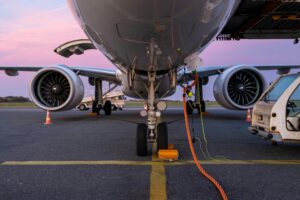Numbers tell stories. When analyzing Nigerian airlines against global performance metrics, the narrative becomes clear and concerning. Based on Nigerian Civil Aviation Authority (NCAA) data, Nigerian carriers consistently operate with on-time performance rates around 48%, while global, Middle East & African, and Low-Cost Carriers maintain rates between 81-83%. This 30-35 percentage point gap represents more than just delayed flights. It signals fundamental operational differences that impact everything from customer satisfaction to financial sustainability.

The contrast becomes even starker when examining specific carriers. FlySafair, the top performer in the Middle East & Africa region according to Cirium’s 2024 On-Time Performance Review, achieved a remarkable 93.82% OTP across 57,272 flights. Meanwhile, some Nigerian airlines struggle to reach even 60% on-time rates.
This performance gap raises critical questions: What drives this disparity? Can Nigeria and Nigerian carriers implement changes to close this gap? And perhaps most importantly, what can be learned from carriers that excel despite operating in similar regional conditions?
Understanding the Performance Gap
The data from Cirium reveals several dimensions to this performance challenge. Beyond basic punctuality, Nigerian airlines show higher cancellation rates compared to global leaders like Aeromexico and Qatar Airways. These metrics point to systemic operational instability rather than isolated incidents.
Several factors contribute to this performance gap:
Infrastructure Limitations: Nigerian airports face challenges with ground operations, air traffic management systems, and basic facilities that directly impact airline punctuality.
Operational Practices: Many Nigerian carriers lack investment in predictive analytics, recovery planning, and efficient turnaround processes that global leaders prioritize.
Fleet Management: Aging or diverse fleets create maintenance complexities that contribute to delays and cancellations.
Regulatory Environment: Inconsistent regulatory frameworks can create unpredictable operating conditions that make schedule adherence difficult.
These challenges compound to create a reliability gap that affects the entire aviation ecosystem, from passenger experience to airline profitability.
The FlySafair Model: Excellence Within Africa
FlySafair’s achievement of 93.82% OTP deserves particular attention, especially considering it operates within the same regional context as many underperforming carriers. This South African low-cost airline ranked first in on-time performance for 11 out of 12 months in 2023, demonstrating that African operational excellence is achievable with the right strategies.
Several key pillars underpin FlySafair’s success:
Operational Precision
FlySafair has built its reputation on meticulous scheduling and quick aircraft turnarounds. The airline uses real-time data to align aircraft, crew, and ground support with precision. Their streamlined boarding, cleaning, and refueling processes consistently achieve fast aircraft turnaround times that maintain schedule integrity throughout the day.
Fleet Simplicity
Unlike many carriers that operate diverse aircraft types, FlySafair maintains an all-Boeing 737-800 fleet. This strategic choice reduces complexity in maintenance, training, and spare parts inventory. Fleet commonality ensures higher aircraft utilization rates and lower downtime, directly contributing to schedule reliability.
Data-Driven Decision Making
Heavy investment in operational data analytics allows FlySafair to monitor bottlenecks and pre-empt delays before they cascade through the network. The airline uses predictive models for staffing, maintenance scheduling, and managing flight disruptions, giving them an edge in maintaining punctuality even when challenges arise.
Collaborative Ground Operations
FlySafair maintains close coordination with South African airports, air traffic control, and ground handlers to pre-clear operational hurdles and manage gate availability. Advanced contingency plans enable rapid recovery from weather or technical issues, minimizing the impact of unavoidable disruptions.
Performance-Oriented Culture
Perhaps most importantly, FlySafair has embedded on-time performance as a core value within its company culture. Employee incentives link directly to on-time metrics, and staff training focuses on punctuality, efficiency, and proactive issue resolution. This cultural commitment transforms punctuality from a metric to a mission.
The Infrastructure Advantage
While FlySafair’s internal operations deserve credit, the airline also benefits from South Africa’s relatively advanced aviation infrastructure. This external support system includes:
Modern Airport Facilities: Airports Company South Africa (ACSA) manages key hubs like OR Tambo (JNB), Cape Town (CPT), and King Shaka (DUR) with advanced air traffic management systems, reliable ground services, and efficient turnaround infrastructure.
Stable Regulatory Oversight: The South African Civil Aviation Authority (SACAA) provides predictable oversight that enables smooth operations planning without disruptive regulatory actions.
Advanced Air Navigation Services: South Africa’s air traffic control network ranks among the most developed in sub-Saharan Africa, contributing to reduced holding times and congestion delays.
Reliable Ground Infrastructure: Fueling, catering, and handling providers generally maintain punctuality and coordination, supporting the airline’s on-time goals.
This infrastructure advantage highlights an important reality: airline performance depends on both internal excellence and external enablers. Nigerian carriers face greater challenges in this regard, but the gap remains larger than infrastructure alone can explain.
Summary: Key Causes of Delays
|
|
South Africa |
Nigeria |
|
Infrastructure |
Occasional congestion |
Chronic under-capacity, ageing facilities |
|
ATC |
Flow control delays |
Coverage, staffing, and comms issues |
|
Airline Operations |
Weather or system faults |
Maintenance delays, poor scheduling |
|
External Disruptions |
Isolated (storms, system outages) |
Frequent (fuel, strikes, weather) |
|
Systemic & Regulatory |
Generally supportive |
Reactive, inconsistent enforcement |
Strategic Imperatives for Nigerian Airlines
For Nigerian carriers seeking to close the performance gap, several strategic imperatives emerge from this analysis:
Invest in Predictive Operations
Global leaders like Delta (83.46% OTP) leverage artificial intelligence and advanced analytics to anticipate disruptions and optimize recovery. Nigerian airlines must prioritize similar technological capabilities, even if at smaller scale. Predictive tools for weather impacts, maintenance needs, and passenger flows can transform reactive operations into proactive management.
Streamline Fleet Strategies
FlySafair demonstrates the power of fleet commonality in maintaining operational reliability. Nigerian carriers should consider the hidden costs of diverse fleets against the apparent benefits of aircraft variety. Standardizing fleet types, even gradually, can yield significant reliability improvements through maintenance efficiency and operational simplicity.
Develop Collaborative Partnerships
Delta’s strong performance correlates with its deep partnership with Atlanta’s Hartsfield-Jackson Airport. Nigerian airlines should pursue similar collaborative relationships with their hub airports, focusing on joint initiatives to improve ground operations, reduce congestion, and enhance passenger processing.
Align Incentives Around Punctuality
On-time performance must become a core value rather than a secondary metric. This requires aligning staff incentives, operational priorities, and customer promises around punctuality. When every employee understands how their role impacts on-time performance, cultural transformation follows.
Invest in Recovery Capabilities
Even perfect operations face disruptions. The difference between high and low performers often lies in recovery capabilities. Nigerian carriers should develop robust disruption management protocols, cross-trained staff, and flexible resource allocation to minimize the impact of inevitable challenges.
The Business Case for Improvement
Beyond operational metrics, the on-time performance gap carries significant business implications. Cirium’s analysis highlights how punctuality directly affects customer satisfaction, crew morale, brand trust, and financial performance.
When flights operate on schedule:
Fuel costs decrease through optimized flight paths and reduced holding patterns
Crew utilization improves with fewer overtime requirements and better staff scheduling
Aircraft utilization increases through more efficient turnarounds and fewer recovery disruptions
Customer satisfaction rises leading to improved loyalty and positive word-of-mouth
These benefits create a virtuous cycle where operational excellence drives financial performance, enabling further investment in capabilities that enhance reliability.
The Path Forward
Closing a 35 percentage point gap requires sustained commitment and strategic focus. Nigerian carriers cannot transform overnight, and they cannot transform alone, but the Nigerian aviation sector can begin a progressive journey toward operational excellence.
The first step involves honest assessment and benchmarking against regional leaders like FlySafair and South Africa. For airlines, understanding specific performance gaps in areas like turnaround times, recovery capabilities, and schedule padding provides the foundation for targeted improvement.
Next comes prioritization of high-impact initiatives that balance cost against potential performance gains. Not every airline can immediately implement comprehensive predictive analytics, but most can improve crew briefing processes, enhance communication protocols, and optimize ground handling coordination.
Finally, carriers must recognize that sustainable improvement requires both internal excellence and external advocacy. Working with regulators, airport authorities, and service providers to address systemic constraints can unlock performance improvements beyond what airlines can achieve independently.
FlySafair’s remarkable performance proves that African operational excellence is achievable with the right combination of discipline, technology, and team alignment. While airline size and funding vary across the continent, many of their strategies remain scalable and adaptable to different operating environments.
The 35% gap represents both a challenge and an opportunity. Nigeria and Nigerian carriers that commit to closing this gap will not only improve their operational metrics but also strengthen their competitive position, financial performance, and customer loyalty. The path exists. The question remains: will Nigeria commit to following it?
Disclaimer: The insights shared in this article are for information purposes only and do not constitute strategic advice. Aviation markets and circumstances vary, and decisions should be based on your organisation’s specific context. For tailored consultancy and guidance, please contact info@avaerocapital.com.




